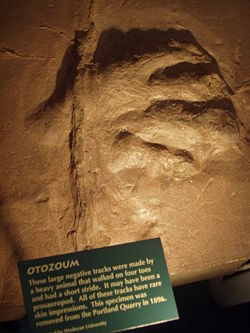
Otozoum
Encyclopedia

Jurassic
The Jurassic is a geologic period and system that extends from about Mya to Mya, that is, from the end of the Triassic to the beginning of the Cretaceous. The Jurassic constitutes the middle period of the Mesozoic era, also known as the age of reptiles. The start of the period is marked by...
age, fossil
Fossil
Fossils are the preserved remains or traces of animals , plants, and other organisms from the remote past...
ized footprints and other markings in sandstones. They were made by heavy, bipedal animals (probably dinosaur
Dinosaur
Dinosaurs are a diverse group of animals of the clade and superorder Dinosauria. They were the dominant terrestrial vertebrates for over 160 million years, from the late Triassic period until the end of the Cretaceous , when the Cretaceous–Paleogene extinction event led to the extinction of...
s) with a short stride that walked on four toes directed forward.
Otozoum tracks were discovered by American paleontologist
Paleontology
Paleontology "old, ancient", ὄν, ὀντ- "being, creature", and λόγος "speech, thought") is the study of prehistoric life. It includes the study of fossils to determine organisms' evolution and interactions with each other and their environments...
Edward Hitchcock
Edward Hitchcock
Edward Hitchcock was a noted American geologist and the third President of Amherst College .-Life:...
, who described Otozoum as the "most extraordinary track yet brought to light in this valley [the Connecticut River
Connecticut River
The Connecticut River is the largest and longest river in New England, and also an American Heritage River. It flows roughly south, starting from the Fourth Connecticut Lake in New Hampshire. After flowing through the remaining Connecticut Lakes and Lake Francis, it defines the border between the...
] representing a bipedal animal... distinguished from all others... in the sandstone of New England".
In 1953, Yale University
Yale University
Yale University is a private, Ivy League university located in New Haven, Connecticut, United States. Founded in 1701 in the Colony of Connecticut, the university is the third-oldest institution of higher education in the United States...
paleontologist Richard Swann Lull revised Hitchcock's work, suggesting that the track maker might have been a prosauropod. Other sources have been proposed, including a crocodile-like animal (e.g. the phytosaur Rutidon), or an ornithopod
Ornithopod
Ornithopods or members of the clade Ornithopoda are a group of ornithischian dinosaurs that started out as small, bipedal running grazers, and grew in size and numbers until they became one of the most successful groups of herbivores in the Cretaceous world, and dominated the North American...
dinosaur, although recent osteological comparisons (e.g., Rainforth, 2003) support Lull's hypothesis that the track maker was indeed a prosauropod.
Hitchcock noted the excellent preservation of some tracks, preserving details of the skin, pads, and even impressions of Jurassic raindrops. Excellent Otozoum specimens from the Portland Quarry may be seen in the Dinosaur State Park and Arboretum
Dinosaur State Park and Arboretum
Dinosaur State Park and Arboretum is a unique state park located 20 minutes south of Hartford at 400 West Street, Rocky Hill, Connecticut, USA. It contains one of the largest dinosaur track sites in North America, with early Jurassic fossil tracks in sandstone from about 200 million years...
in Rocky Hill, Connecticut
Rocky Hill, Connecticut
Rocky Hill is a town in Hartford County, Connecticut, United States. The population was 17,966 at the 2000 census. Rocky Hill was part of Wethersfield, the neighboring town to the north, until it was independently incorporated in 1849....
.

